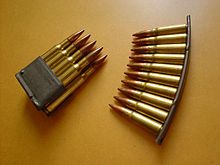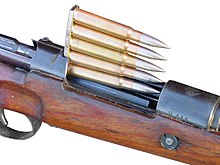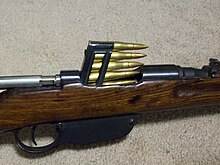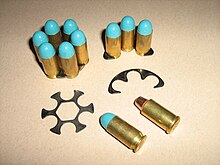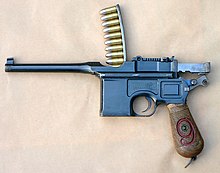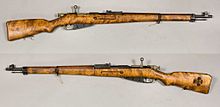
A semi-automatic rifle is an autoloading rifle that fires a single cartridge with each pull of the trigger and uses part of the fired cartridge's energy to eject the case and load another cartridge into the chamber. In contrast, a bolt-action rifle requires the user to cycle the bolt manually before they can fire a second time, and a fully automatic rifle fires continuously until the trigger is released.

Bolt-action is a type of manual firearm action that is operated by directly manipulating the bolt via a bolt handle, most commonly placed on the right-hand side of the firearm. The majority of bolt-action firearms are rifles, but there are also some variants of shotguns and handguns that are bolt-action. A firearm using bolt-action mechanism is colloquially referred to as a bolt gun.

In firearms terminology, an action is the functional mechanism of a breech-loading firearm that handles the ammunition cartridges, or the method by which that mechanism works. Actions are technically not present on muzzleloaders, as all those are single-shot firearms with a closed off breech with the powder and projectile manually loaded from the muzzle. Instead, the muzzleloader ignition mechanism is referred to as the lock.
A semi-automatic firearm, also called a self-loading or autoloading firearm, is a repeating firearm whose action mechanism automatically loads a following round of cartridge into the chamber and prepares it for subsequent firing, but requires the shooter to manually actuate the trigger in order to discharge each shot. Typically, this involves the weapon's action utilizing the excess energy released during the preceding shot to unlock and move the bolt, extracting and ejecting the spent cartridge case from the chamber, re-cocking the firing mechanism, and loading a new cartridge into the firing chamber, all without input from the user. To fire again, however, the user must actively release the trigger, allow it to "reset", before pulling the trigger again to fire off the next round. As a result, each trigger pull only discharges a single round from a semi-automatic weapon, as opposed to a fully automatic weapon, which will shoot continuously as long as the ammunition is replete and the trigger is kept depressed.

A magazine, often simply called a mag, is an ammunition storage and feeding device for a repeating firearm, either integral within the gun or externally attached. The magazine functions by holding several cartridges within itself and sequentially pushing each one into a position where it may be readily loaded into the barrel chamber by the firearm's moving action. The detachable magazine is sometimes colloquially referred to as a "clip", although this is technically inaccurate since a clip is actually an accessory device used to help load ammunition into a magazine or cylinder.

A battle rifle is a service rifle chambered to fire a fully powered cartridge.

The Mannlicher M1895 is a straight pull bolt-action rifle, designed by Ferdinand Ritter von Mannlicher that used a refined version of his revolutionary straight-pull action bolt, much like the Mannlicher M1890 carbine. It was nicknamed the Ruck-Zuck-[Gewehr] by Austrian troops and "Ta-Pum" by Italian troops who wrote a song (it) about it during World War I. The primary producers were the ŒWG in Steyr, and FÉG in Budapest.
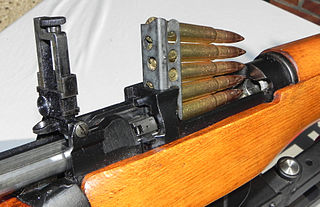
A stripper clip is a speedloader that holds several cartridges together in a single unit for easier and faster loading of a firearm magazine.
The Type 4 rifle, often referred to as the Type 5 rifle, was a Japanese experimental semi-automatic rifle. It was based on the American M1 Garand with an integral 10-round magazine and chambered for the Japanese 7.7×58mm Arisaka cartridge. Where the Garand used an 8-round en-bloc clip, the Type 4's integral magazine was charged with two 5-round stripper clips and the rifle also used Japanese-style tangent sights.
A rim is an external flange that is machined, cast, molded, stamped, or pressed around the bottom of a firearms cartridge. Thus, rimmed cartridges are sometimes called "flanged" cartridges. Almost all cartridges feature an extractor or headspacing rim, in spite of the fact that some cartridges are known as "rimless cartridges". The rim may serve a number of purposes, including providing a lip for the extractor to engage, and sometimes serving to headspace the cartridge.

A speedloader is a device used to reduce the time and effort needed to reload a firearm. Speedloaders come in a variety of forms for reloading revolvers, or the magazines used with other types of firearms such as rifles and shotguns.
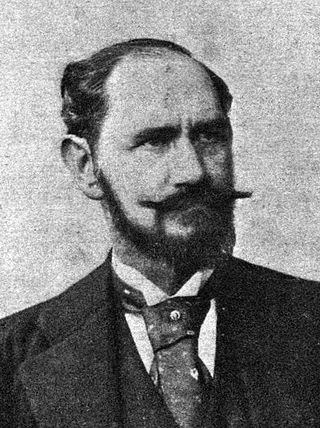
Ferdinand Ritter von Mannlicher was an Austrian engineer and small arms designer. Along with James Paris Lee, Mannlicher was particularly noted for inventing the en-bloc clip charger-loading box magazine system. Later, while making improvements to other inventors' prototype designs for rotary-feed magazines, Mannlicher, together with his protégé Otto Schönauer, patented a perfected rotary magazine design, the Mannlicher–Schönauer rifle, which was a commercial and military success.
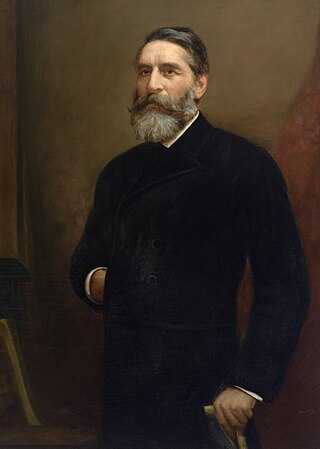
James Paris Lee was a British Canadian inventor and arms designer. He is best known for having invented the Lee Model 1879 rifle, which is the first bolt-action detachable box magazine-fed rifle. These features would be incorporated into more successful repeating rifle designs later on, such as in the Lee–Metford and Lee–Enfield rifle series.

The FÉG 35M was a bolt-action rifle chambered in 8×56mmR. Though superficially still resembling the 95/31M Carbine, it was a new design with a cock-on-close bolt. An easily recognizable distinguishing feature was the placement of the bolt handle, which was further forward than in the 1895 design. It was used by Hungary in the years leading up to and during World War II, as well as after World War II, yet was gradually phased out by both Red Army surplus, and locally produced Mosin–Nagant carbines in the years after.

In firearms, the cylinder is the cylindrical, rotating part of a revolver containing multiple chambers, each of which is capable of holding a single cartridge. The cylinder rotates (revolves) around a central axis in the revolver's action to sequentially align each individual chamber with the barrel bore for repeated firing. Each time the gun is cocked, the cylinder indexes by one chamber. Serving the same function as a rotary magazine, the cylinder stores ammunitions within the revolver and allows it to fire multiple times before needing to reload.

The Geweer M. 95, also known to collectors as the Dutch Mannlicher, was the service rifle of the armed forces of the Netherlands between 1895 and 1940 which replaced the obsolete Beaumont-Vitali M1871/88. At first it was produced by Steyr for the Dutch, but after 1904, production took place under license at a Dutch state weapon factory in Zaandam known by the name of close by Hembrug bridge. Although often regarded as being based on the earlier Mannlicher 1893 Model, the rifle is in fact a modification of the Mannlicher rifle by August Schriever and the Dutch rifle commission. The Dutch issued about 470,000 M.95s.
The 6.5×53mmR, originally and more correctly produced as the 6.5×53.5mmR, and in imperial system nomenclature known as the .256 Mannlicher, is a late 19th-century rimmed centerfire military rifle cartridge similar to other early smokeless powder designs.

The Mannlicher M1893 is a bolt-action rifle that was the standard service rifle of the Kingdom of Romania from 1893 to 1938. The rifle and its 1892 predecessor were the first repeating rifles to be widely issued in the Romanian military. It was later replaced by the Czechoslovak-designed Vz. 24 as the standard service rifle.
